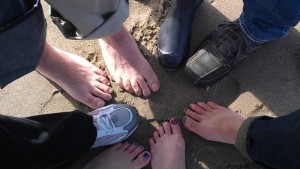Decorating your walls with big data
Now art can be meaningful in a whole new sense. Images created from self-tracking data can make for some interesting and often beautiful creations. Wonder what you can do with the data you already have? Everything from your cursor movements to your music listening history could be decorating your humble abode before you know it, check out the article for more ideas. Imagine all the possibilities you’ll have with your Memoto camera!
Read more: Doing beautiful things with self-tracking data
Watch: Laurie Frick describes her artistic quantified self
Life tracking at CES
Video just released this week on the trends seen at CES.
Self-tracking is already commonplace among US adults
A study by Pew Internet and American Life Project has found many adults in the US already self-track health issues, although only 21% use technology to help track. “One surprising finding was that nearly 50 percent of trackers in the survey say they do it in their head. Study author Susannah Fox calls these trackers the “skinny jeans trackers”—people who pay attention to whether or not their pants fit.” What about you? Are you in the 21%? If so, what do you use, tell us in the comments?
Read more: Many Americans Do Some Self-Tracking, But Mostly It’s in Their Heads
Tictrac launching next month
Those you wanting to aggregate all your self-data won’t have to wait much longer. The TicTrac software will do it all for you. “For example, you can analyze how your stress levels change during periods of high email consumption. Or if you’re a runner, you can see if factors like sleep and weather affect your performance.” Looks pretty cool and I can’t wait to check it out!
Read more: This Startup Measures How Much Stress Email Gives You, And Helps You Reduce It
More Mood Tracking
The article offers tips for the new mood tracker: Keep it simple, try new things and be aware of yourself and your environment. The biggest takeaway, from my perspective, is the point on Awareness. “Awareness alone can be transformative. Once you see a pattern, it’s very hard to un-see it. If you can accept what you see, then make some small changes to your life, and then once again become aware of how you react, you will start to learn how your mood can be influenced by the things you do and the conditions around you.”
We’ve talked about the DIY Mood Tracking series in previous TWILs. Don’t miss them!
Read more: DIY Mood Tracking (Get Your Mood On: Part 4)
Wearable technology
Wearable technology is popping up everywhere, from Smart watches like Mutewatch, to fitness trackers like Fitbit and lifelogging technologies like Google Glass and our own Memoto camera. You’re sure to see these pieces of technology becoming an everyday part of people’s lives. “Personal wearable-collected data can be extremely powerful when it helps bring tangible benefits – such as reducing hassle, saving money, or successfully helping fight or manage chronic disease.”
Read more: Making the wearable tech revolution a reality
Do you get our Newsletter? Sign up!
Subscribe to Memoto’s newsletter






